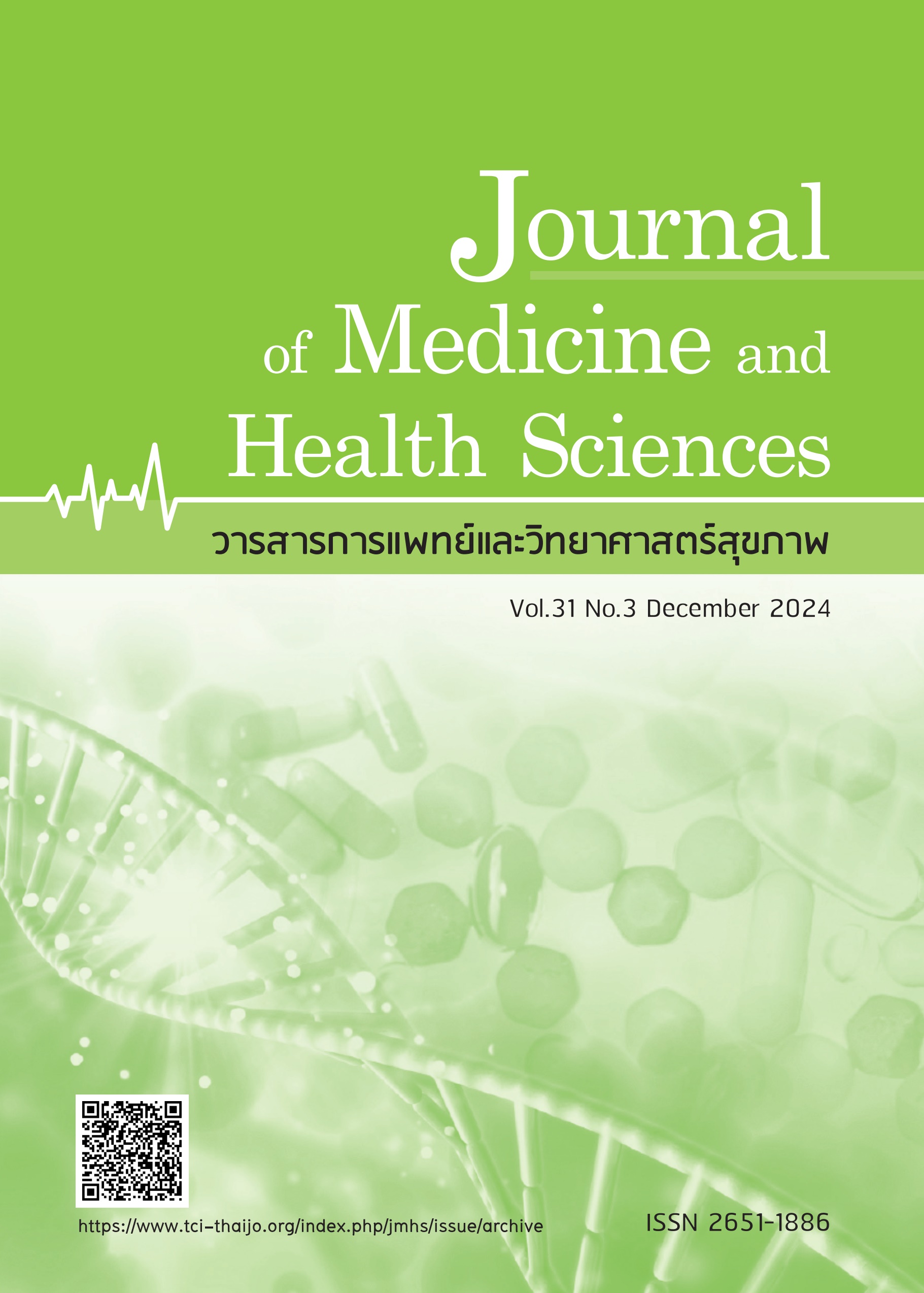Development of a model for practicing venipuncture and intravenous fluid administration
Keywords:
innovation, venipuncture, intravenous fluid administration, natural rubberAbstract
Quality and safe nursing practices, professional nurses and nursing students must possess accurate, precise, and proficient nursing skills. This developmental innovation research aimed to create and develop a model for practicing venipuncture and intravenous fluid administration made from natural rubber. The study was conducted in three phases: 1) assessing the needs for a skill training model among nursing students, newly graduated nurses, nursing instructors, and nursing laboratory staff 2) designing and developing the model, including formulating a latex compound, testing its initial properties, creating a prototype using the developed formula, assessing its quality and conducting trials, and 3) evaluating the model's effectiveness. The sample consisted of 45 second-year nursing students and 30 newly graduated professional nurses. Data were collected using questionnaires assessing the model's features and effectiveness. Instrument reliability was verified through the Index of Item-Objective Congruence (IOC), which ranged from 0.67 to 1.00, and Cronbach’s alpha coefficients, which were 0.81 and 0.83. Quantitative data were analyzed using descriptive statistics, while qualitative data were analyzed through content analysis. The results revealed that the model, made from natural rubber, had a rectangular shape (7 cm wide, 12 cm long, and 1 cm thick). Its base was supported by a thin steel plate to prevent needle penetration. The model included two blood vessels connected to a 20-50 milliliter syringe and was stitched onto a rubber cloth for attachment to body areas where skill practice was required. During the trial phase, fourth-year nursing students rated the model’s features at a very good level (M=4.59, SD=0.51), while professional nurses rated them at a good level (M=4.49, SD=0.50). For effectiveness, second-year nursing students rated the model at a very good level (M = 4.55, SD=0.51), while newly graduated professional nurses rated it at a good level (M=4.46, SD=0.56). This skill-training model can be used for three applications: as a part task trainer, with a full-body manikin, and with simulated patients by attaching it to relevant body areas for practice or hybrid simulator.
References
Commission on Higher Education Standard. Announcement from the higher education standards committee subject details of learning outcomes according to the higher education qualification standards [Internet] 2022 [cited 15 October 2022]. Available from: https://www.ops.go.th/th/ches-downloads/edu-standard/item/. (in Thai)
Athonvarangkul P, Dibyamadala J, Mangkhang C. The implementation of hybrid learning approach for digital task based language teaching (DTBLT). Soc Sci Res Aca J 2022;17:13-29. (in Thai)
Panich V. How does learning happen? Bangkok: S.R. Printing Mass products company limited;2013. (in Thai)
Thailand Nursing and Midwifery Council. Regulations of the nursing and midwifery council on approval of professional education curriculum for professional nursing and midwifery [Internet] 2020 [cited 15 October 2022]. Available from: https://www.tnmc.or.th/images/userfiles/files/T_0036(2).PDF (in Thai)
Kumkong M. Nasae J. Risk management in nursing practicum. South College Net J Nurs Public Health 2020;7:10-22. (in Thai)
Pongwichai S. Statistical analysis by computer focused on research. 20th ed. Bangkok: Chulalongkorn University Press. 2009.
Beck CT. Reliability and validity issues in phenomenological research. West J Nurs Res 1994;16(3):254-62;discussion 262-7. doi:10.1177/019394599401600303.
Rattanapan S, Artchomphoo J, Saijun D. The use of a co-filler between silica and crumb rubber in natural rubber latex foam products. BUU SCI J 2021;26:90-104. (in Thai)
Siriwong C, Boonchiangma S. Sulfur vulcanization of rubber compounds. KKU Sci J 2021;46:1-13. (in Thai)
Nontaput T, Chotiban P. Intravenous venipuncture: new development in training on arm manikin. South College Net J Nurs Public Health 2021;8:49-56. (in Thai)
Chaiyasang P, Machompoo N, Sakulkhaemaruethai C. et al. Development of an innovative model from natural rubber for practicing suture skills. Bcnnon Hlth Sci Res J 2022;16:13-25. (in Thai)
Billings L, Allen P, Armstrong M, et al. Creating and launching. Innovative nursing education programs: Perils and pearls. Nurs Educ Perspect 2012;33(5):292-6. doi:10.5480/1536-5026-33.5.292.
Anurak C, Prommul J, Fuengthin A. et al. Research and innovation in nursing: An infant heel venipuncture-training nanikin. South College Net J Nurs Public Health 2024;11:1-13. (in Thai)
Bandura A. Social cognitive theory: An agentic perspective on human nature. New Jersey: Wiley & Sons; 2023.
Promchaisri K, Lerkiatbundit S, Saengcharoen W. Effect of self-efficacy enhancing program on ability to use insulin-penfill injection among patients with diabetes type 2: A randomized controlled trial. Thai J Pharm Prac 2019;11:648-58. (in Thai)
Downloads
Published
How to Cite
Issue
Section
License
Copyright (c) 2024 Journal of Medicine and Health Sciences

This work is licensed under a Creative Commons Attribution-NonCommercial-NoDerivatives 4.0 International License.





